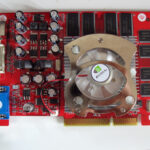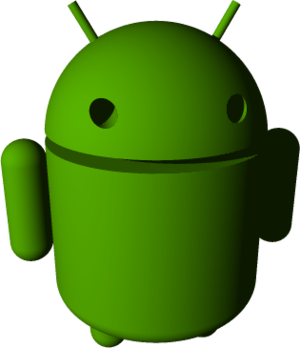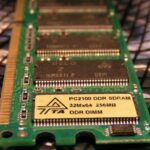I figured I would write a post to explain to laymen the limitations of Android tablets, and how memory works. There seems to be a bit of confusion about memory on a tablet. Android tablets have three different types of memory; internal RAM, micro-SD, and SD. Think of internal RAM as the amount of memory your desktop computer has. Most desktop computers have at least 1 GB of RAM in this day and age.
You can look at the micro-SD card inside of the tablet as your hard drive. Most desktop computers have a 500 GB hard drive. Finally, you can look at the regular SD card as your external hard drive. This is where things get interesting. Most consumers do not have external hard drives because they are not necessary for the use of a desktop. Most desktop computers store everything on their internal hard drives. In fact, in most cases the only reason a consumer purchases external storage is when they want to store large amounts of movies or songs, in that they would keep back more of the internal hard drive for the use of the operating system. Desktop operating systems have a very large cache, and they will eat into that internal hard drive if the space is available to them.
In most cases the operating system is already set up to compact or expand the cache as needed, based on what the operating system thinks is necessary from what it can tell over time. If you use programs that require large amounts of memory, such as video games, or perhaps you listen to a lot of music or watch a lot of movies and your hardware is not capable of storing all of the information needed to play back those files without buffering the size of your cache expands. The amount of memory your computer has can be in RAM your computer can augment by caching data on your internal hard drive.
On a tablet, the micro-SD card stores all of the applications and the SD card stores your audio and video files. You do not store audio and video files on the micro-SD card, you store applications. The iPad works differently from Android in that you are provided with a set amount of RAM that is used for the execution of programs, and a set amount of internal storage that cannot be changed or altered. An Apple tablet comes in three different configurations, 16 GB, 32 GB, or 64 GB. Once that storage is exhausted you can either delete the files you do not need, or you can rent storage from Apple. That extra storage is in the cloud, meaning that it can only be accessed while you are online.
Tablets do not come with a lot of memory, because they run off of operating systems that do not require the large amounts of memory that desktop computers do. It is not unusual for a tablet to run off of as little as 128 MB of RAM, with 1 GB of storage on the micro-SD card and 4 GB of storage on the external card. One thing that consumers often forget is that with an Android tablet changing the amount of memory they have available to them internally and externally is as easy as changing the SD card inside of their smartphone or digital camera. On an Android tablet, you can use a card as large as 32 GB; both internally and externally. This means that you could purchase two 32 GB cards, a micro-SD for applications and a regular SD for music and video, and have a total of 64 GB of storage.
If you need more than 64 GB of storage, there are solutions that allow you to store files in the cloud. Google Music allows you to store 20,000 songs for free. Currently that limitation applies to actual number of files, not the length of the files, so there is no actual figure on how much storage this actually is, although Google does state that the maximum length of a file should be 250 MB. Right now the biggest song I have is 46 MB, and I always record at the maximum 320 bit resolution for my MP3 files. In any event you could, theoretically, store 4.8 terabytes of data on Google Music.
Another option is to use YouTube to store video files. Most people do not know that you can limit who watches files uploaded to YouTube. You could set those files for private viewing so that you are the only one that can see them. Currently there are no storage limits on YouTube.
Regardless of whether your tablet comes installed with 128 MB of RAM, or 1 GB of RAM the option to expand still RAM, you still have the option to expand the amount of storage you have for songs and videos up to 64 GB internally, and of course, there is an infinite amount of storage available on the cloud. However, you need to know what your tablet is, and is not, capable of doing. If the retailer tells you that the tablet has 4 GB of storage internally it is a safe bet that the tablet comes with 512 MB of RAM and can play back video and run applications like Google Music without problems. On the other hand the retailer tells you, that the tablet only has 2 GB of storage internally, you are probably looking at 256 MB tablet that may or may not be able to play video effectively. The Kindle Fire and the first iPad are great examples of 256 MB tablets that can handle video without any problems, but I do not have enough experience with 256 MB tablets to tell you if this will be the case on similar tablets.
Most retailers, and a lot of manufacturers, will not tell consumers how much RAM they actually have. In most cases, someone opened up the tablet, published the information online, and made that information available to consumers that are doing their own research. One rule of thumb I have come up with is that your available RAM will be one eighth the amount of your internal memory. So 1 GB of internal memory translates into 128 MB of RAM, 2 GB/256 MB, 4 GB/512 GB, 8 GB/1 GB, and so on. In the case of the iPad, this formula does not work because the iPad has always come in 16 GB/32 GB and 64 GB internal memory configurations. This much we do know for sure, the iPad has 256 MB, the iPad 2 has 512 MB, and the iPad 3 has 1 GB. The iPad 4 will probably have 2 GB, whenever Apple decides to inform the public of a new iPad, and this is of course if the naming convention continues.
For the purposes of this article, I have not focused on Windows tablets because these are high-end devices that aren’t aimed at consumers that do not have the same 32 GB memory limitations that Android devices have. Windows 8 is a much larger operating system than Android, and needs to access more memory. They use a solid state drive as opposed to SD cards, and often come with 2 GB of RAM, and a 128 GB drive, just like a Windows desktop with a solid state drive does. Windows 8 is also a work in progress. Windows 7 tablets never took off with consumers, and will probably fade out of existence as Windows 8 becomes more popular. Right now the high cost of Windows tablets, which seem to cost at least $500 or more, in comparison to Android devices, some of which are as cheap as $50, will probably ensure their niche status, unless manufacturers offer low end devices that can compete with the iPad, Kindle Fire, and Nook Color. Then again, low-end for a Windows tablet will end up being a 64 GB solid state drive and 2 GB of RAM.
To summarize this article, make sure your tablet has at least 512 MB of RAM, or 4 GB of internal storage, if you plan to play movies on it. Remember that while you can store applications on the external SD card, the default is to store applications on the internal micro-SD card, and that some applications can run on the external card and some cannot. Bibles are a great example of applications that will not run without the external SD card installed. The size of applications change as the software is run, which is one of the reasons why memory requirements are not listed in the app store when you install them. The same app may install at 27 MB, but once ran, could balloon all the way up to 75 MB. If an app does not open, go into the Task Manager and figure out what apps you wish to kill. The Task Manager will have its own recommendations of which programs are safe to kill, just be sure the app you’re actually using does is not one you kill by accident. There is no limit on the amount of programs you can have running at one time. It will not be unusual for you to have hundreds of apps installed, even on a smaller 1 GB micro-SD card, but chances are you will only run up to 30 apps at any one time. Have fun, and enjoy your tablet!




